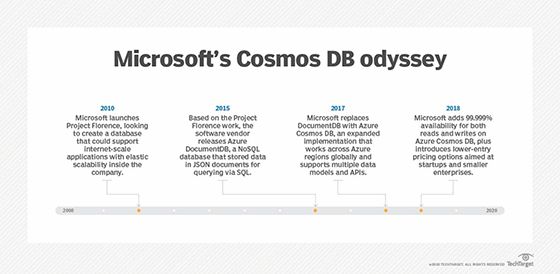
Sergey Nivens - stock.adobe.com
5 cloud database comparison tips to guide your data strategy
Catch up on these tips that compare the strengths, weakness and available integrations of popular public cloud database and analytics services from AWS, Microsoft and Google.
Organizations host vast amounts of data in the cloud, compiled in a variety of data types and structures. The database and analytics services that handle this data are central pieces of an organization's cloud strategy, which is why enterprises must ensure their chosen services meets their structure, availability and security requirements.
Google, Microsoft and AWS offer an extensive range of database and analytics services tailored to different needs. But with the overwhelming amount of choices, it can be a challenge to know which database or analytics service fits your specific requirements.
Use these five tips to help choose the right one. Whether you want to boost your analytics capability or need a service to handle unstructured data, these cloud database comparisons will ease the selection process.
Compare Google Firebase Realtime Database or Google Cloud Firestore
Google Firebase Realtime Database and Google Cloud Firestore are two of the NoSQL database options available on Google Cloud Platform. Both support mobile and web application development, but differ in terms of data structure, offline support, security and querying capabilities. Firebase Realtime Database, the original NoSQL database on the Firebase platform, can handle simple data, while Cloud Firestore is more suitable for complex data structures and querying needs. Take a closer look at Google Cloud Firestore vs. Firebase Realtime Database to determine which database meets your application and data requirements.
Break down Azure Cosmos DB uses and capabilities
Organizations often have many different kinds of data to store and process, which means they'll need more than one type of database. Azure Cosmos DB, a multimodel database fabric, offers support for various database types, such as graph, document and relational. Cosmos DB provides the benefits of scale-out architecture without common consistency issues. Explore the core capabilities and uses for Azure's multimodel database and how it stacks up to NoSQL databases from other cloud providers, particularly Amazon DynamoDB.

Machine learning and serverless updates improve BigQuery, but work remains
BigQuery, Google's big data analytics service, processes large read-only data sets. Recent updates to BigQuery have focused on machine learning and real-time analytics, as well as serverless capabilities. Compared to querying services from other cloud providers, such as Amazon Redshift and Azure SQL Data Warehouse, Google BigQuery provides faster queries for large data sets, but it has some catching up to do in areas such as regional availability, data imports and numeric support. See where BigQuery stands among its competitors with this overview on notable updates and remaining shortcomings.
DocumentDB vs. DynamoDB: Compare AWS NoSQL databases
AWS users have two choices when it comes to native document databases. DynamoDB is a managed key-value store that supports document data, and DocumentDB is a managed service with MongoDB compatibility. These databases fall within the same category but differ in important ways. For example, DynamoDB is better for applications that access data on unique keys, while DocumentDB offers more flexible indexing options. Evaluate DocumentDB vs. DynamoDB with this AWS cloud database comparison.
AWS data lake vs. data warehouse options for the cloud
Data lakes and data warehouses help organizations ingest and analyze large sets of data in the cloud, and AWS provides native services for both options. Developers can build data lakes with AWS Lake Formation or build a data warehouse with Amazon Redshift. In this cloud database comparison tip, learn the differences in features and use cases for data lakes and data warehouses on AWS, and identify ways these technologies can work together for storage and analytics.








